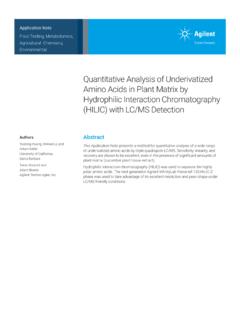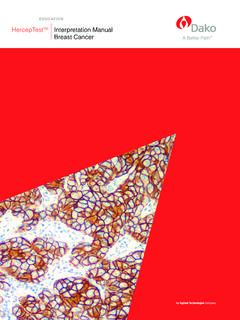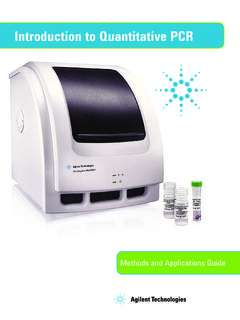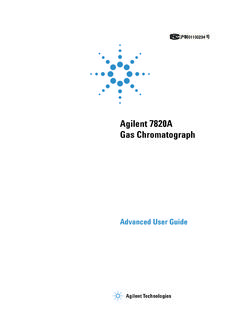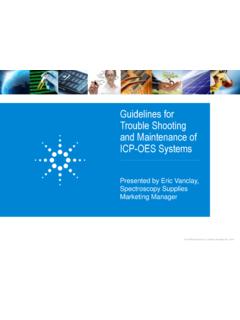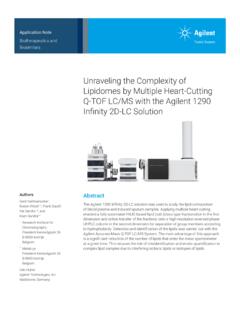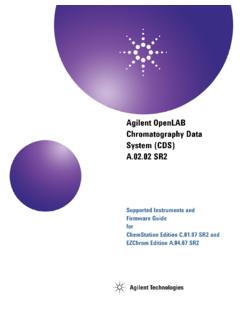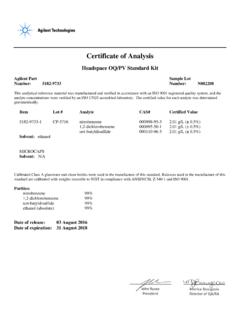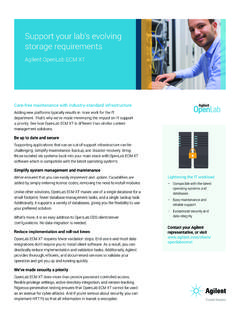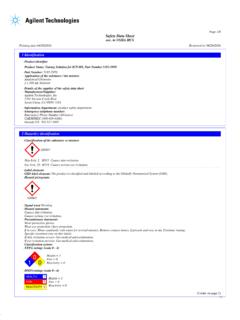Transcription of Basics of LC/MS (5968-2543E)
1 Basics of LC/MSA PrimerContentsIntroduction ..2 Instrumentation ..4 Interfacing LC and MS ..4 Atmospheric Pressure Ionization ..4 API-Electrospray ..5 Atmospheric Pressure Chemical Ionization (APCI) ..6 Scan and SIM ..7 Collision-Induced Dissociation ..8 Adapting LC Methods ..9 Applications ..10 Molecular Weight Determination .. 10 Combinatorial Chemistry .. 12 Pharmaceutical Applications .. 13 Biochemical Applications .. 14 Clinical Applications .. 16 Food Applications .. 16 Environmental Applications.
2 182 Sample TypesLC/MS systems facilitate the analysis of samples that traditionally have beendifficult to analyze. Despite the power andusefulness of gas chromatography /massspectrometry (GC/MS), many compoundsare impossible to analyze with GC/MS. LC/MS significantly expands the effectiveanalytical use of mass spectrometry to amuch larger number of organic chromatography and GC/MS can beused to analyze a small percentage of the 9 million registered compounds. BecauseIntroductionLiquid chromatography / mass spectrometry ( LC/MS ) is fast becoming the preferredtool of liquid chromatographers.
3 It is a powerful analytical technique that combinesthe resolving power of liquid chromatography with the detection specificity of massspectrometry. liquid chromatography (LC) separates the sample components andthen introduces them to the mass spectrometer (MS). The MS creates and detectscharged ions. The LC/MS data may be used to provide information about the molecu-lar weight, structure, identity and quantity of specific sample components. they impart little or no heat to the analytemolecules, LC and LC/MS -based methodscan be applied to most organic types range from small pharma-ceutical compounds to large proteins.
4 Because it is a much more widelyapplicable method than GC/MS, LC/MS is suitable for the analysis of large, polar,ionic, thermally unstable and involatilecompounds. Some of these compounds can be made amenable to GC/MS byderivatization, but LC/MS eliminates the need for time-consuming chemicalmodifications. This permits MS analysis ofnon-volatile, thermallylabile, or WeightAnalyte PolarityAPI-ElectrosprayGC/MSParticleBea mAPCI1000100,00010,000nonpolarvery polarFABT hermosprayFigure 1. Applications of various LC/MS techniques3 Selectivity and SensitivityA mass spectrometer combined with a liquidchromatograph can detect masses charac-teristic of a compound or of a class ofcompounds.
5 The system can selectivelydetect compounds of interest in a complexmatrix, thus making it easy to find andidentify suspected impurities at trace configured to simultaneously detect a range of masses (and depending on thecompound) LC/MS sensitivity can be com-parable to that provided by a diode-arraydetector (DAD). Far greater sensitivity ispossible when the LC/MS is configured todetect only those masses characteristic ofthe compounds being InformationUsing MS in combination with other LCdetectors gives richer information. Forexample, a DAD acquires data on selectedultraviolet (UV) and visible (Vis) wave-lengths and spectra.
6 This information isuseful for identifying unknown peaks andfor determining peak purity or for both. An MS acquires mass information bydetecting ions; it offers molecular-weightand structural information. The LC/MS can be used with analytes that do not have chromophores. The two orthogonalsets of data can be used to confidentlyidentify, confirm, and quantitatecompounds. In addition, an LC/MS can be used as a highly selective andsensitive tunable detector. An MSchromatogram for a single mass oftenproduces an interference-free signal thatoffers high precision and low minimumdetection limits.
7 Using both a UV detector and a massselective detector is more effective than using either one alone. There arecompounds (such as metabolites ordegradents) for which the UV-Vis spectra of two analytes will be very similar and it may be difficult to detect an impuritybased on UV spectra alone. It is alsopossible to have impurities that have thesame mass , especially at lower molecularweights. It is rare,however, for twocomponents to haveidentical UV-Vis spectra and 2 shows theability to separatepolymer componentsfrom an unresolvedpeak using theinformation availablein a mass separation would not be possibleusing a conventionalUV 2.
8 Separation of isomers in a chromatographically unresolved peak4000008000001200000MS TIC20004000m/z 10152025303540100200300m/z 13254000800012000m/z 3764 Interfacing LC and MSThere has been a major focus on improvingthe interface between the LC and the chromatography uses high pressureto separate a liquid phase and produces ahigh gas load. mass spectrometry requiresa vacuum and a limited gas load. Forexample, common flow from an LC is 1 ml/min of liquid which, when convertedto the gas phase, is 1 l/min. However, atypical mass spectrometer can accept onlyabout 1 ml/min of gas.
9 Furthermore, an LC operates at near ambient temperaturewhere as an MS requires an elevatedtemperature. There is no mass rangelimitation for samples analyzed by the LC but there are limitations for an MSanalyzer. Finally, LC can use inorganicbuffers and MS prefers volatile buffers. Recent developments in atmosphericpressure ionization sources have expandedthe molecular weight, sample polarity, and flow-rate limitation of older LC/MStechniques. In many cases, analysts areable to use unmodified high-pressure LC methods. InstrumentationLC/MS systems have improved dramatically over the last 20 years.
10 Instruments havebeen transformed from complex, high-cost, highly advanced research tools to low-cost,robust, easy-to-use routine detectors. And, as the instruments have been refined, moreapplications have been PressureIonization Atmospheric pressure ionization (API)techniques are soft ionization processeswell suited for the analysis of large and small, polar and nonpolar, labilecompounds. These techniques can be used to rapidly confirm the identity of a wide range of volatile and nonvolatilecompounds by providing sensitive and accurate molecular-weight andfragmentation information.
